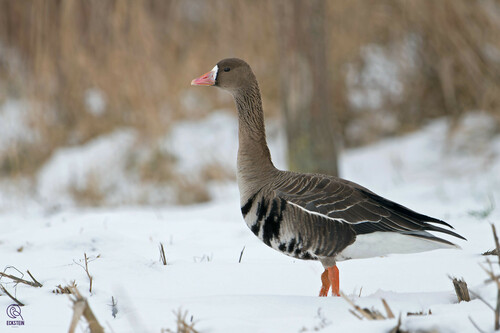
Greater White-fronted Goose
The Greater White-fronted Goose (*Anser albifrons*) is a medium-sized goose known for its distinctive white facial patch and orange legs. It plays a crucial role in wetland and grassland ecosystems as a grazer and seed disperser. This species has a wide distribution across the Northern Hemisphere, exhibiting impressive migratory behaviors. While not holding major cultural significance in many areas, they are a popular game bird in some regions.
64-81 cm
Length
130-165 cm
Wingspan
Least Concern
Conservation Status
Distribution
Breeds in the Arctic tundra regions of North America, Europe, and Asia. Migrates south for winter, reaching as far as the southern United States, Mexico, southern Europe, and parts of East Asia. Altitudinal range varies from sea level to high-altitude tundra.
Lifespan
Typical lifespan in the wild is 10-15 years, though some individuals can live longer.
Greater White-fronted Goose's Habitat
Habitat Types
Arctic Tundra, Wetlands, Grasslands, Agricultural Fields (during migration and winter)
Climate Zones
Arctic, Subarctic, Temperate
Adaptations
Dense down feathers provide insulation in cold climates. Broad bills are adapted for efficient grazing. Strong legs and webbed feet facilitate both walking on land and swimming.
Variations
Several subspecies are recognized, differing slightly in size and plumage, including the Pacific White-fronted Goose (*A. a. frontalis*) and the Tule Goose (*A. a. elgasi*).
Appearance
Breeding Plumage
Plumage is generally similar year-round, though it may appear fresher and brighter after molting.
Seasonal Feather Changes
Limited seasonal variation, primarily in the brightness of the plumage.
Sex Based Plumage Differences
Minimal sexual dimorphism; males and females have similar plumage.
Notable Features
White patch around the base of the bill (the 'white front'), Dark barring on the belly (variable in extent), Orange legs and feet, Pink bill with a white nail
Diet and Feeding
Primary Foods
Grasses, Sedges, Aquatic plants, Berries, Grains (especially during migration and winter)
Foraging Behavior
Primarily grazes on land, often in large flocks. Also feeds in shallow water by dabbling or upending.
Specializations
Serrated edges on the bill help to efficiently cut and consume grasses.
Seasonal Diet Variations
Diet shifts with availability; relies more on grains and agricultural crops during migration and winter when tundra vegetation is less accessible.
Behavior
Social Structure
Highly social, forming large flocks during migration and winter. Breeding pairs are territorial.
Communication
Loud, honking calls, Head and neck displays, Wing flapping
Migration
Undertakes long-distance migrations between breeding and wintering grounds. Migrates in large flocks, often following traditional routes.
Territorial or Group Behaviors
Breeding pairs defend territories around their nests. Outside of the breeding season, they are highly gregarious.
Conservation
Threats
Habitat loss (wetlands and grasslands), Climate change (affecting tundra breeding grounds), Hunting pressure (in some regions), Disturbance at breeding and staging areas
Protection Programs
Migratory Bird Treaty Act (in North America), AEWA (Agreement on the Conservation of African-Eurasian Migratory Waterbirds), Wetland conservation initiatives
Local National Laws
Protected under various national and international laws regulating hunting and habitat protection.
Population Trend
Stable
Population Estimates
Global population estimated to be in the millions.
Interesting Facts
They are known for their long-distance migrations.
Some populations travel thousands of kilometers between their breeding and wintering grounds.
The white patch on their forehead varies in size and shape.
This variation can help researchers identify individual birds.
They are sometimes called 'Specklebellies'.
This nickname refers to the dark barring on their bellies.
Faqs about Greater White-fronted Goose
What is the difference between a Greater White-fronted Goose and a Greylag Goose?
Greater White-fronted Geese have a distinctive white patch around the base of their bill, orange legs, and dark barring on the belly, which Greylag Geese lack. Greylag Geese are also generally larger.
Where can I see Greater White-fronted Geese?
During migration and winter, they can be found in wetlands, grasslands, and agricultural fields across their range. Consult local birdwatching guides for specific locations.
Are Greater White-fronted Geese endangered?
No, they are currently classified as Least Concern by the IUCN.
Copyright @ Nature Style Limited. All Rights Reserved.
 English
English